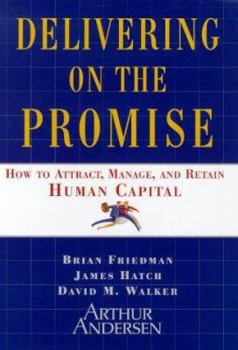Delivering on the Promise: How to Attract, Manage and Retain Human Capital
Select Format
Select Condition 
Book Overview
Business has long struggled with the notion of "human capital," but do companies really know the value of their people? All too frequently, companies lay off thousands of workers to boost share price... This description may be from another edition of this product.
Format:Hardcover
Language:English
ISBN:0684856581
ISBN13:9780684856582
Release Date:October 1998
Publisher:Free Press
Length:240 Pages
Weight:1.07 lbs.
Dimensions:1.0" x 6.4" x 9.6"
Customer Reviews
3 ratings
"The Five Stages of Human Capital Appraisal."
Published by Thriftbooks.com User , 24 years ago
"Most companies have human resources personnel and various HR policies and programs", B. Friedman, J. Hatch, and D. M. Walker write, "but few companies know their value-or how to enhance it. In the view of too many corporate chiefs, HR managers are mere functionaries implementing programs that are no more than extra costs to be cut in times of trouble...Everyone in progressive organizations recognizes that the HR function must become more closely linked to strategy. As the HR function evolves from administrative to strategic, the question can be asked (and objectively answered), what are we doing to enhance the value of human capital in our organization? Although the effectiveness of the HR department is a part of this answer, it is only one part. Arthur Andersen has developed an approach that can help companies measure the value of all policies affecting human capital, and align these policies more closely to corporate goals. This method, which we can call 'Human Capital Appraisal', shows how companies can measure and increase the returns on their investments in people (p.39)."In this context, they describe a series of necessary five stages in the management of human capital covering the five major human capital areas as (a). recruitment, retention, and retirement, (b). rewards and performance management, (c).career development, succession planning, and training, (d). organizational structure, and (e). human capital enablers, as follows:1. Stage One - Clarification: In this stage, companies identify and confirm their overall business direction or strategy in the broadest sense of the terms.(for a detailed discussion of this stage see Chapter 4)2. Stage Two - Assessment: In this stage, companies calculate the cost of investment in human capital, and the value employees place on this investment.(for a detailed discussion of this stage see Chapter 5)3. Stage Three - Design: In this stage, companies begin to create programs that can yield better returns on human capital. (for a detailed discussion of this stage see Chapter 6)4. Stage Four - Implementation: In this stage, companies put these proposed changes into practice. (for a detailed discussion of this stage see Chapter 7)5. Stage Five - Monitoring: In this stage, companies check this new system. (for a detailed discussio of this stage see Chpter 8) As conclusion, they argue that 'Human Capital Appraisal' is a holistic approach based on the two equally important dimensions of stages and areas-time and space. It is in the squaring of these elements that the real substance of human capital development can emerge. By following a sequence for enhancing human capital, and by ensuring coverage of all areas within each part of the sequence, companies can improve their returns on investment in this area-by far the most critical for companies today (p.45).Strongly recommended for executives and HR professionals.
Excellent
Published by Thriftbooks.com User , 25 years ago
A long-awaited book on the topic of Human Capital. A worthy investment
A rigorous investment perspective of the human organization.
Published by Thriftbooks.com User , 26 years ago
The meaning of the term "human capital" is far from clearly established, but the authors press for the need to shift management's perspective of people from a supply or resource to being capital, requiring investment and valuation. With this view of organization as their springboard, the authors present a model for managing human capital that applies a five stage process to five broadly defined HR areas or functions. A central theme is that there must be a fit between human capital programs and strategy, along with a focus on cost and value.The aim of measuring the effectiveness of human capital remains a subject to be further explored in a sequel to this book. Overall, this is a worthy effort to create a more rigorous investment-oriented mindset for thinking about, and proactively addressing, the human dimension of organization.





